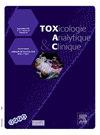Main results of the IN CADAVER protocol: The value of using dried blood spots (DBS) in post-mortem forensic toxicology
IF 1.8
Q4 TOXICOLOGY
引用次数: 0
Abstract
Aim
In recent years, post-mortem analytical toxicology has undergone significant technical advances (pre-analytical extraction stage and analytical instruments), improving analysis performance. However, two challenges remain unchanged: (1) biological samples, usually autopsy samples, of several milliliters in size, constituting time-consuming and costly pre- and post-analytical management seals, and (2) difficulties in interpretation due to in cadaver phenomena during the post-mortem period (degradation and PMR), in vitro instability, and imperfections of reference systems for interpretation. In addition, in our experience, toxicological analysis as part of the search for the cause of death can be carried out correctly 9 out of 10 cases using post-mortem blood analysis alone. To overcome the two challenges mentioned above, the IN CADAVER protocol explores the possibility of carrying out such tasks using 70 μL of capillary blood collected at the time of foreign body removal. With the agreement of the judicial authorities, this single-center protocol aims to compare the toxicological results obtained (1) in micro-samples versus conventional samples taken during autopsy (T2), and (2) in micro-samples taken during body removal (T1) versus autopsy ones (T2). Here are the main results.
Method
The blood micro-samples consist of 2 DBS of 10 μL (VAMS Mitra Neoteryx) and 50 μL on a fluorinated microtube dedicated to capillary blood sampling. These micro-samples are taken (capillary vein of the foot or femoral artery) at T1 and T2, and are only analyzed when toxicological analyses are required. All samples were analyzed using the same methods (LC-HRMS, LC-MS/MS and HS-CG-FID), with additional assays for alcohol biomarkers (PEth and EtG) in the micro-samples. Only cases with positive toxicological results are finally included in the IN CADAVER protocol.
Results
Seventy-two cases of death were sampled, 35 of which were requisitioned for toxicological analysis: 33 revealed the presence of xenobiotics (mean age 41 years-old; sex-ratio 3.4; 45 hours as mean time between T1 and T2).
At T2, all the molecules detected in the autopsy blood samples were also detected in the micro-samples, and the differences between the concentrations measured in the autopsy blood samples and the autopsy micro-samples do not affect the interpretation. There was no significant difference between the blood concentrations of ethanol, PEth and ETG measured at T1 and T2. With regard to opiates, the main finding was that in 2 out of 3 cases, 6-MAM was only detected (at T1 and T2) in DBS. Certain opioids such as tramadol (and N-desmethyltramadol) showed an increasing trend between T1 and T2 (suggesting PMR). THC and related metabolites were detected in all 3 blood samples, but the concentrations measured in DBS were lower (probably due to the extraction difficulty from this sampling system). Concentrations of cocaine and its metabolites are generally DBS T1 > DBS T2 > blood T2 due to both in cadaver degradation and in vitro stabilization on DBS. The same trend was observed for benzodiazepines (e.g. oxazepam, temazepam, alprazolam, bromazepam, 7-aminoclonazepam).
Conclusion
On an analytical point of view, quantitative results obtained in micro-samples versus conventional samples are similar (with the exception of cannabinoids). On a forensic point of view, use of DBS sample enhances interpretation (e.g. heroine, cocaine, benzodiazepines intakes) and provides an easier way to take blood samples during body removal. This approach favors the interpretation of results obtained from a blood sample taken as close as possible to the time of death, regardless of the sampling area [1]. In this way, as a first step, DBS samples will be systematically added to other autopsy samples for toxicological investigations at the Lille Institute of Forensic Medicine in 2025.
IN CADAVER 方案的主要结果:在死后法医毒理学中使用干血斑(DBS)的价值
近年来,尸检分析毒理学在分析前提取阶段和分析仪器等方面取得了重大的技术进步,提高了分析性能。然而,两个挑战仍然没有改变:(1)生物样本,通常是尸检样本,大小为几毫升,构成耗时和昂贵的分析前和分析后管理密封;(2)由于尸检期间的尸体现象(降解和PMR),体外不稳定性以及解释参考系统的不完善,在解释方面存在困难。此外,根据我们的经验,在寻找死因的过程中,毒理学分析10例中有9例是正确的,仅使用死后血液分析。为了克服上述两个挑战,IN CADAVER方案探索了在异物移除时使用70 μL的毛细血管血液来执行这些任务的可能性。在司法当局的同意下,本单中心方案旨在比较(1)尸检过程中采集的微样本与常规样本(T2)的毒理学结果,以及(2)尸体移除过程中采集的微样本(T1)与尸检过程中采集的微样本(T2)的毒理学结果。以下是主要结果。方法血液显微标本分别为10 μL (VAMS Mitra Neoteryx)和50 μL,在专用于毛细管采血的氟化微管上采集。在T1和T2采集这些微样本(足部毛细血管或股动脉),只有在需要进行毒理学分析时才进行分析。所有样品使用相同的方法(LC-HRMS, LC-MS/MS和HS-CG-FID)进行分析,并对微样品中的酒精生物标志物(PEth和EtG)进行附加分析。只有毒理学结果呈阳性的病例才最终被纳入in CADAVER方案。结果72例死亡病例中,35例进行毒理学分析,33例发现有外源性药物,平均年龄41岁;性别比例3.4;T1和T2之间的平均时间为45小时)。在T2时,尸检血液样本中检测到的所有分子也在微样本中检测到,并且尸检血液样本和尸检微样本中测量到的浓度之间的差异不影响解释。T1和T2时血中乙醇、PEth和ETG浓度差异无统计学意义。关于阿片类药物,主要发现是3例中有2例仅在DBS (T1和T2)中检测到6-MAM。某些阿片类药物如曲马多(和n -去甲基曲马多)在T1和T2之间呈增加趋势(提示PMR)。3份血样中均检测到四氢大麻酚及相关代谢物,但DBS中检测到的浓度较低(可能是由于该采样系统难以提取)。可卡因及其代谢物的浓度一般为DBS T1 >;DBS T2 >;血液中T2的减少是由于尸体降解和体外稳定的DBS。苯二氮卓类药物(如恶西泮、替马西泮、阿普唑仑、溴西泮、7-氨基氯硝西泮)也有同样的趋势。从分析的角度来看,在微量样品中获得的定量结果与常规样品相似(大麻素除外)。从法医的角度来看,使用DBS样本可以增强解释(例如,海洛因、可卡因、苯二氮卓类药物的摄入量),并提供了一种在尸体移除过程中更容易采集血液样本的方法。这种方法有利于解释从尽可能接近死亡时间的血液样本中获得的结果,而不管采样区域如何。这样,作为第一步,DBS样本将在2025年系统地添加到里尔法医研究所的其他尸检样本中,用于毒理学调查。
本文章由计算机程序翻译,如有差异,请以英文原文为准。
求助全文
约1分钟内获得全文
求助全文

 求助内容:
求助内容: 应助结果提醒方式:
应助结果提醒方式:


